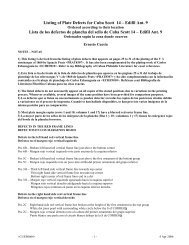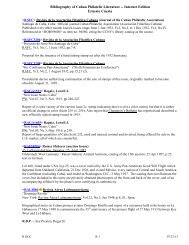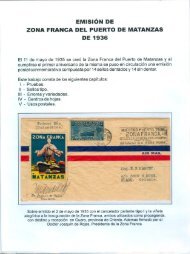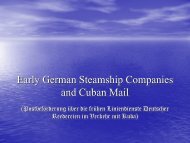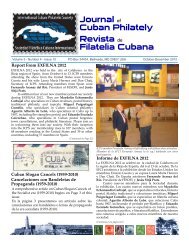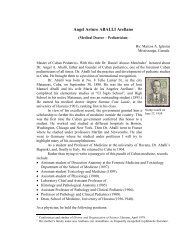The Cuban Philatelist - Ernesto Cuesta
The Cuban Philatelist - Ernesto Cuesta
The Cuban Philatelist - Ernesto Cuesta
You also want an ePaper? Increase the reach of your titles
YUMPU automatically turns print PDFs into web optimized ePapers that Google loves.
El Sr. Prats menciona el artículo de Peter A. Robertson<br />
en ‘Opinions IV’ publicado por la Philatelic Foundation en<br />
1987 pero no dice nada sobre las pruebas de laboratorio<br />
independientemente realizadas a las que se sometió el sello<br />
en 1985. El reporte de laboratorio original dice lo siguiente:<br />
“Un examen de la superficie impresa del sello sobre cubierta<br />
usando un microscopio 100-300X indica lo siguiente:<br />
1. No hay evidencia de distorsión de las fibras del papel, ya<br />
sea de forma mecánica o química.<br />
2. El pigmento rojo naranja en el centro del “4,” y justo por<br />
debajo, es de la misma densidad que el pigmento a la<br />
derecha y a la izquierda de las líneas cruzadas del “4.”<br />
Un análisis espectrofotométrico de rayos x de la tinta<br />
de la sobrecarga del sello sobre cubierta revela lo siguiente:<br />
Es virtualmente idéntica en composición y grosor de capa al<br />
negro carbón usado en los ejemplares normales; existe sólo<br />
una diferencia menor en densidad en comparación con una<br />
de las sobrecargas normales, y no hay variaciones medibles<br />
al compararlo con tres (3) sobrecargas normales (Nota: La<br />
Philatelic Foundation sometió el sello en cuestión para su<br />
análisis junto con cuatro ejemplares con la sobrecarga ‘Y<br />
1/4’ genuina de 1860 para su comparación).<br />
Basándome en la información anterior, es mi opinión<br />
que la sobrecarga del sello en cubierta no ha sido alterada<br />
de ninguna forma.”<br />
Peter A. Robertson en ‘Opinions IV’ también dijo: “No<br />
hay absolutamente ninguna evidencia de que la sobrecarga<br />
haya sido cambiada, ni de que el sello no provenga de este<br />
sobre. El sello está matasellado con los canceladores propios<br />
de la época, y, por supuesto, fue usado en La Habana. El<br />
sello no ha sido removido del frente de este sobre.”<br />
La aseveración del Sr. Prats de que la sobrecarga ha<br />
sido alterada no está de acuerdo ni con el reporte de<br />
laboratorio presentado a la Philatelic Foundation o con lo<br />
que Peter Robertson escribió en 1987. Yo tampoco estoy de<br />
acuerdo con las conclusiones del Sr. Prats.<br />
Veamos el sello: Éste sin duda proviene de la esquina<br />
inferior izquierda de la hoja por consiguiente está en la<br />
posición 154 como dice el Sr. Prats. Por lo que parece que él<br />
dice que el sello tiene una sobrecarga ‘Y 1/4’ de la posición<br />
154 de la hoja y que el ‘1’ ha sido cambiado a un ‘4’ y que el<br />
‘4’ ha sido cambiado a un ‘1.’<br />
En su artículo él provee una ilustración agrandada de<br />
la sobrecarga ‘Y 1/4’ normal de la posición 154 por lo que se<br />
implica que esta es la sobrecarga ha sido alterada. Sin<br />
embargo, este no es el caso. Si uno sencillamente sobrepone<br />
la sobrecarga normal y el error en la posición 154 usando la<br />
‘Y’ como punto fijo, entonces se puede ver claramente que<br />
hay una discrepancia entre las dos sobrecargas. En el error<br />
el ‘4’ está más alto que el ‘1’ en el sello normal y la barra de<br />
fracción también está un poco más alta. El ‘1’ en el error<br />
está más alto y a la izquierda de la barra vertical del ‘4’ que<br />
<strong>The</strong> <strong>Cuban</strong> <strong>Philatelist</strong>. Last Half 2005.<br />
fakes and forgeries but any such pieces were vastly outnumbered<br />
by genuine items.<br />
Mr. Prats does mention the article by Peter A. Robertson in<br />
Opinions IV published by the Philatelic Foundation in 1987 but<br />
fails to comment on the independent laboratory analysis of the<br />
stamp carried out on behalf of the Philatelic Foundation in 1985.<br />
<strong>The</strong> original laboratory report on the stamp states the following:<br />
“An examination of the printed surface of the specimen on cover<br />
using a 100-300X scope indicated the following:<br />
1. <strong>The</strong>re is no evidence of paper fibre distortion, either by<br />
mechanical abrading or chemical stress.<br />
2. <strong>The</strong> reddish orange pigment lying at the center line of the “4,”<br />
and just below it is of the same density as pigment depositions to<br />
the right and left of the x-bar of the “4.”<br />
An x-ray spectrophotometric analysis of the overprint ink on<br />
the specimen on cover revealed the following:<br />
It is virtually identical in composition and thickness of film to the<br />
carbon black used on the regularly printed examples; there exists<br />
only a minor difference in density compared to one of the normal<br />
overprints, and no measurable variation when compared with<br />
three (3) regular overprints (Note: <strong>The</strong> Philatelic Foundation<br />
submitted the stamp in question for analysis along with four other<br />
examples of genuine 1860 ‘Y 1/4’ surcharges for comparison<br />
purposes).<br />
Based on the information detailed above, it is my opinion that<br />
the overprint on the specimen on cover has not been altered in any<br />
manner.”<br />
Peter A. Robertson in Opinions IV also said: “<strong>The</strong>re is<br />
absolutely no evidence that the surcharge has been changed, nor<br />
that the stamp did not originate on the cover front. <strong>The</strong> stamp is<br />
tied by the proper grid and circular date stamp in use in Havana<br />
around this date, and, of course, it is used in Havana. <strong>The</strong> stamp<br />
has not been off this cover front.”<br />
Mr. Prats’ assertion that the surcharge has been altered does<br />
not agree with either the laboratory report presented to the<br />
Philatelic Foundation or to what Peter Robertson wrote in 1987. I<br />
also do not agree with Mr. Prats’ assertion.<br />
Moving to the stamp itself: <strong>The</strong> stamp certainly comes from<br />
the lower left corner of the sheet and is therefore position 154 on<br />
the sheet as stated by Mr. Prats. It would therefore seem that he is<br />
saying that this stamp was a genuine copy of the ‘Y 1/4’ surcharge<br />
on this stamp from position 154 on the sheet and that the ‘1’ has<br />
been changed to a ‘4’ and the ‘4’ has been changed to a ‘1.’<br />
In his article he kindly provides a blow-up illustration of the<br />
normal ‘Y 1/4’ surcharge from position 154 and he must therefore<br />
[have] been saying that this is the surcharge that has been altered.<br />
However, this is not the case. If one does a simple overlay test on<br />
the normal and error surcharges from position 154 using the ‘Y’ as<br />
a constant then one can clearly see there is a discrepancy between<br />
the two surcharges. On the error surcharge the ‘4’ is positioned<br />
higher than the ‘1’ on the normal stamp and the crossbar is also<br />
slightly higher on the error surcharge. <strong>The</strong> ‘1’ on the error<br />
46



